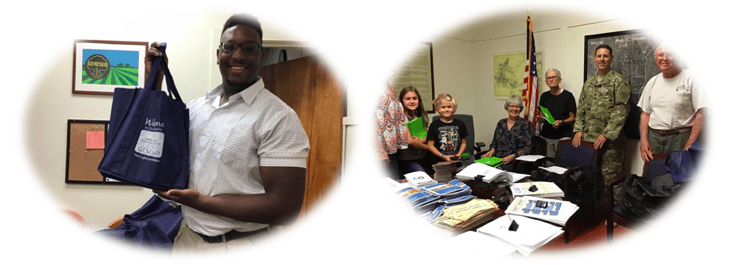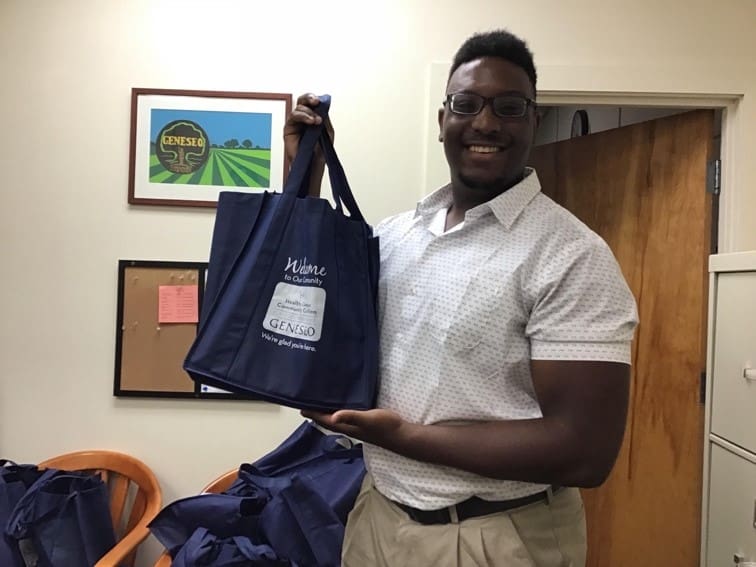
“Geneseo is a town of about 10,500, located in the Finger Lakes region of New York, about 30 miles south of Rochester,” said the coalition’s Prevention Specialist Robert Levy. “The town and surrounding area are quite rural. Students come from throughout New York state, the majority from the New York metropolitan area.”
“The Healthy Campus and Community Coalition (HC3) was founded in 2003 as a partnership between the State University of New York College at Geneseo and the village of Geneseo, composed of students, community members and other stakeholders,” said Levy. “Our purpose is to collaboratively mitigate the risks of alcohol and other drug consumption, creating a respectful and inclusive community and promoting individual well-being. In 2017 we received a five-year state Environmental Prevention grant, which enabled us to hire a community-college substance misuse prevention coordinator and fund various campus and community initiatives.”
“Aside from taking a short break to allow people to adjust to working at home, full-time parenting and other changes, we’ve resumed our meetings by Zoom,” said Levy. “Initially, we just checked in to see how everyone is doing. Then, as much as possible, we’ve begun meeting in sub-groups to work on projects.”
“Participation is slightly up, as more people are able to make the afternoon general meeting time,” said Levy. “Work groups have begun working outside of general meeting times (normally, we break into groups at the general meeting). Most students have moved back home, but those who are members are still joining meetings. I am keeping the general membership up to date by email, as usual, and occasionally posting on our Facebook page. We are re-vamping our website to keep it current and expand its reach.”
“Our assessment work group is working with a data analyst to analyze a student survey that was done in the fall and will prepare presentations to be provided either virtually or at coalition and community meetings,” said Levy. “The capacity-building workgroup collected our promotional materials into an electronic format and is reviewing our membership list to see who is active and identify gaps. The strategic planning workgroup is working with a local PR non-profit to develop a social norms campaign for the fall. The college-community connections work group is looking at events that can be planned for late summer to welcome students back, either in-person or virtually.”
“I think people want to be connected and be a part of creating something during this time, even if it’s just a plan,” said Levy. “All planning has to do with making contacts, thinking about resources needed or available and bringing together sectors and groups, such as the Main Street Business Association, Rotary, the Chamber of Commerce, regional promotion groups, faith leaders, media, student leaders and college support staff. Everybody is still out there and may be less busy than usual. The wonder of virtual meetings is that people don’t have to drive anywhere, they can just join in from home. I’m hoping that in the future we can build capacity and sustainability by holding virtual meetings in the late afternoon or evening, when more students and parents are available.”
“I actually have a little more time and focus for work,” said Levy. “Normally, I have a 35-minute commute each way, so working from home reduces wear and tear. I miss working directly with students. Being new, I was connecting with student clubs, and we were planning coffee houses, dances, open mic nights, game nights and so on as a way of providing alternatives to drinking and getting more student involvement with the coalition. The AOD coordinator and I have a great group of student interns who were doing Safe Party and Narcan trainings and planning to do focus groups with other students and community members. Now I have to think about, if students can’t come back in the fall, how are we going to implement environmental prevention strategies? I’m working on next year’s budget and work plan, and it’s almost like I have to have two versions – in-person and virtual.”
“I always think of a coalition as being like an electrical network with many nodes – the members or sectors,” said Levy. “Each node has some energy to contribute. Right now, many people are sitting home, sometimes alone, and may be looking for something to do. Think of the initiatives you were working on before the pandemic. How can you break tasks down so that something, anything can be accomplished? Choose some people who you think might want to get together – who is your Rotary member? Who’s that retiree who knows the community so well? and try to get in touch. Connectivity is essential. Without it you don’t have a circuit, energy doesn’t flow. When you get people together, particularly at this time, there’s often good energy and willingness to do something.”
“As much as possible, maintain your normal structure,” said Levy, “meeting time, agenda, tasks and committees. We all need structure now.”



